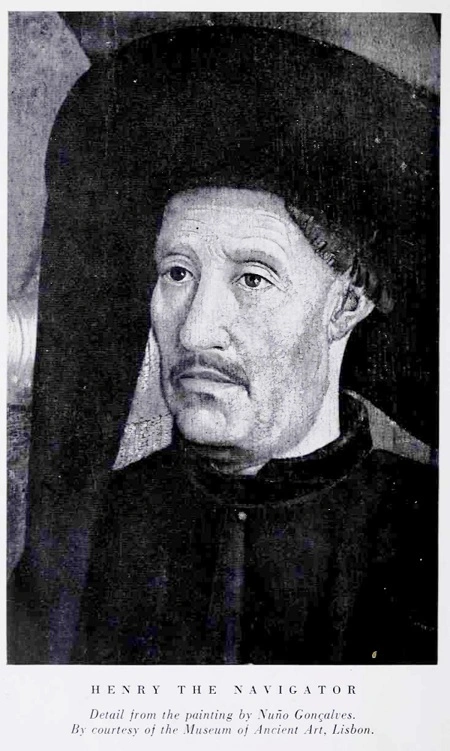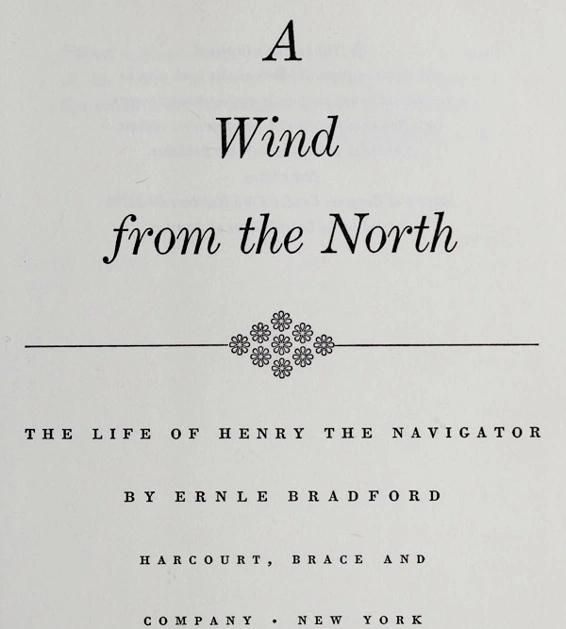A Wind From the North

A
WIND
FROM
THE
NORTH

Table of Contents
PREFACE
1
2
3
4
5
6
7
8
9
10
11
12
13
14
15
16
17
18
19
20
21
22
23
24
25
26
27
List of Sources Notes Index
Chronology
List of Sources
Notes
Chapter One
Chapter Two
Chapter Four
Chapter Five
Chapter Six
Chapter Eight
Chapter Nine
Chapter Ten
Chapters Fourteen and Fifteen
Chapter Seventeen
Chapter Eighteen
Chapter Twenty
Chapter Twenty-two
Chapter Twenty-seven
Index
ABOUT THE AUTHOR


© 1960 by Ernie Bradford All rights reserved. No part of this book may be reproduced in any form or by any mechanical means, including mimeograph and tape recorder, without permission in writing from the publisher, first edition
Library of Congress Catalog Card Number: 60-12730 Printed in the United States of America
“What is Alexander crowned with trophies at the head of his army,
compared with Henry contemplating the ocean from his window on the rock of Sagres?”
W. J. MICKLE, 1775
PREFACE
❖
Enthusiasm fathered this book. I am not a Portuguese scholar or a historian of any distinction, so it may seem an impertinence to have attempted a biography of Portugal’s great national hero. My interest in Prince Henry came about by accident. Some years ago, I was sailing in a small yacht from Gibraltar to the West Indies and by chance called in at the port of Safi on the Moroccan coast. There was one building that immediately impressed me—and which still remains in my memory—the old Portuguese fortress on the heights surmounting the town. It was the first I had ever seen, but I know now that there are many such fortresses on lonely coves and headlands throughout the world, or overlooking flourishing cities and big modem ports. They are the monuments to the Portuguese sailors and pioneers who opened the sea lanes of the world, and blazed the trail that was afterward followed by all the other maritime nations. It was on this same voyage that I sailed to the Canaries, and then took my departure for the New World from the Cape Verde Islands. I found again that I was following in the footsteps of the Portuguese, men who in boats little bigger (and much more primitive) than my forty-foot yacht had preceded me by at least five centuries.
A few years later I sailed in a small yacht to Lisbon and down the coast of Portugal to Cape St. Vincent and Sagres. The shadow of the Navigator lies heavy across that stretch of sea. I felt that he had been unfairly neglected in the English-speaking countries. Since then I have sailed to Madeira and the Azores—on each occasion in a boat of about twenty tons, a little smaller perhaps than the caravels of Prince Henry’s time, but equipped with modern charts, efficient instruments, and a navigational knowledge, all of which stemmed from Prince Henry and his pioneers. A practical acquaintance with sailing, seamanship, and navigation, in the areas in which the Portuguese made their first voyages, gave me an added appreciation of the problems they had to face. In a crossing by yacht from the Azores to New York, I also—by sheer chance— followed a route very similar to that which Diogo de Teive must have taken when he sailed from Flores to the Newfoundland Banks.
I have anglicized the names of many of the principal characters in this biography—thus, Prince Henry for the Infante Dom Henrique and Prince Peter for the Infante Dom Pedro. In other respects I have followed the Portuguese spellings, except in the case of certain geographical place names where I have preferred those better known to English-speaking mariners—such as Cape Blanco for Cabo Branco and so on.
None of the dialogue is invented, although in many cases I have paraphrased or modernized the diction slightly. The biographer of Prince Henry is fortunate in having so reliable a contemporary chronicler as Azurara to draw on for his source material. Other principal authorities I have indicated at the end of this book, but I must not omit to mention the debt that any historian of the period must owe to the researches of R. H. Major in the nineteenth century. I am indebted for his kindness and help to Sr. A. B. F. Mendes, director of the Casa de Portugal, London, also to the authorities of the British Museum, the National Maritime Museum, Greenwich, the Royal Academy of Arts, Burlington House, and the Museum of Ancient Art, Lisbon. The researches of Sr. Quirino da Fonseca on the ships of Prince Henry’s time are invaluable to any biographer of the Prince.
Prince Henry has had his detractors as well as admirers, and any who feel that I may have taken too favorable a view of him and his achievements are recommended to read J.
1 comment